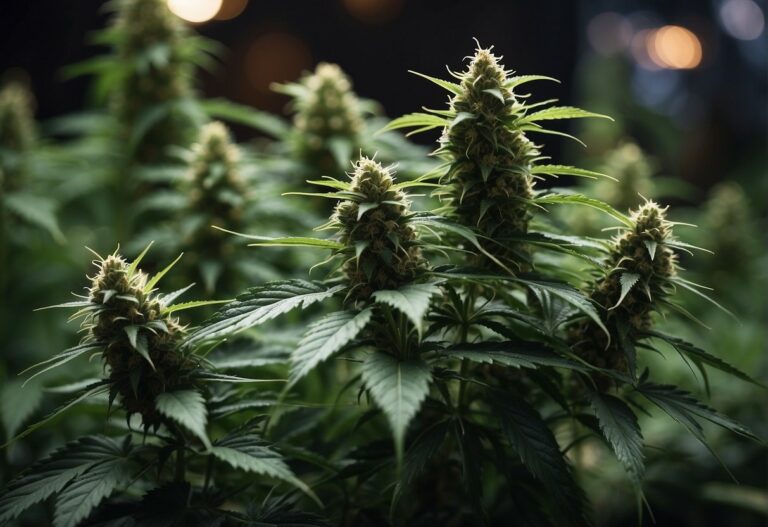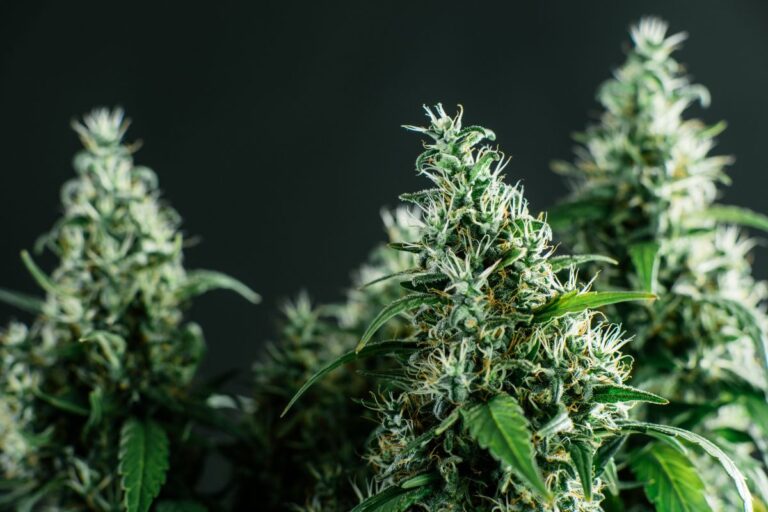How to Make Weed Stem Tea: A Simple Guide for Potent Brews
Discover the magic of **weed stem tea**! Leaf lovers, pay attention: it’s time to quit tossing those stems! Imagine making a warm, welcoming cup of tea from the very stems we used to discard after picking the buds. Who would have thought? There’s wonder in those forgotten pieces! Filled with goodies like THC and CBD, these neglected leftovers become a calming tea. It’s ideal for anyone eager to explore the cannabis scene minus the smoky haze. Stick around, and you’ll uncover how to turn yesterday’s trash into today’s chill elixir.
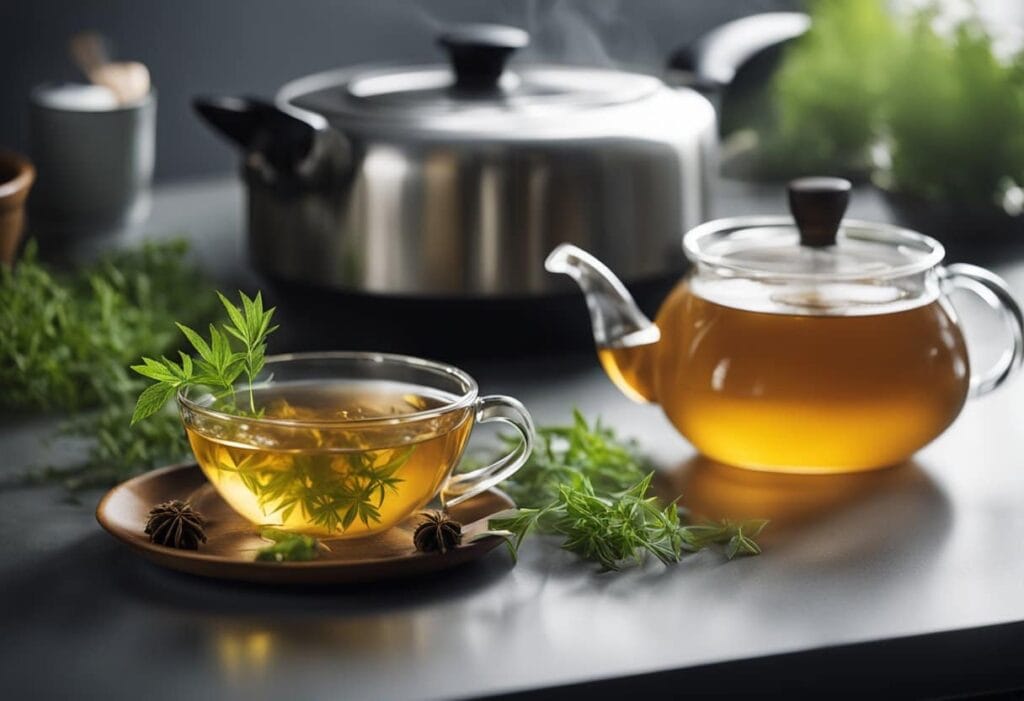
Making tea from weed stems is not only a matter of sustainability but also offers a unique experience distinct from the high associated with more traditional methods. While the concentration of THC in stems is lower compared to the flower, the infusion process can still release enough of the active compounds to produce a mild effect, along with the purported medical benefits of the cannabinoids.
The process of making weed stem tea is straightforward and requires only a few additional ingredients to enhance the solubility and absorption of the cannabinoids. Since THC and CBD are not water-soluble, incorporating fats or alcohol can aid in their release from the stems during brewing. Such a method ensures the tea provides both flavor and function, making it an attractive option for those seeking to repurpose their cannabis remnants into a potentially beneficial and enjoyable drink.
Benefits of Weed Stem Tea

Weed stem tea provides an alternative method of consumption for those interested in the advantages of cannabinoids without the need for smoking. Its preparation leverages the often-discarded parts of the plant, offering medical, recreational, and environmental benefits.
Medical Uses
Weed stem tea is purported to contain various cannabinoids, including THC and CBD, which may offer medical benefits. These compounds have been studied for their potential to relieve symptoms such as chronic pain, nausea, anxiety, and depression. Moreover, the tea can be a soothing choice for those seeking improved sleep quality.
Recreational Aspects
From a recreational standpoint, weed stem tea can provide a discreet and smoke-free option for consuming THC, the psychoactive component of cannabis. This method allows users to experience the effects of THC in a less intense, more controlled manner, which can be particularly appealing for new users or those sensitive to smoke.
Environmentally Friendly
Finally, the preparation of weed stem tea embraces an environmentally friendly approach by reducing waste. Typically, stems are discarded as a byproduct of cannabis consumption, but by repurposing them into tea, one can minimize waste and make the most out of the entire plant.
Preparation Essentials
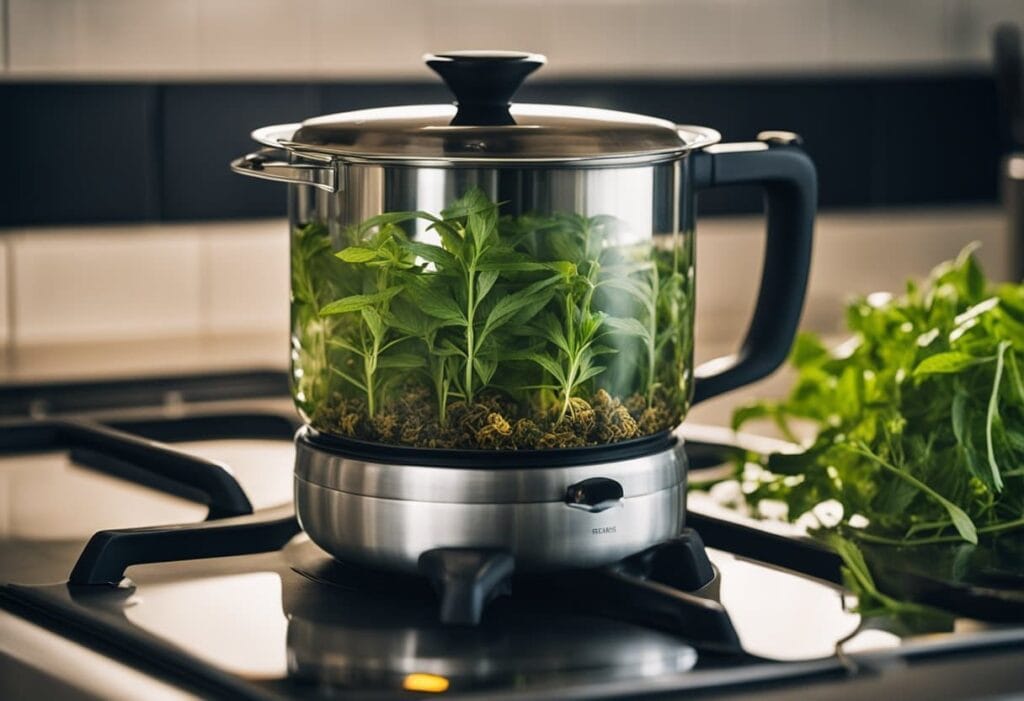
When crafting weed stem tea, one embarks on a meticulous journey of selecting suitable stems, initiating the decarboxylation process, and mastering solubility. Adhering to each step with precision is crucial for achieving the desired potency and effectiveness of the cannabinoids within the tea.
Choosing the Right Stems
Selecting the right stems is paramount—they should be from the cannabis plant and have a certain level of dryness and brittleness. The stems to look for are those with minimal traces of green, as this indicates a lower presence of THC. Grind the stems finely, but not to powder, to increase the surface area, ensuring a more comprehensive extraction of cannabinoids.
Decarboxylation Process
Before infusion, stems must undergo decarboxylation, a critical heat-induced chemical reaction that converts THCa in cannabis into psychoactive THC. Decarboxylation can be achieved by:
- Preheating the oven to 220°F (105°C).
- Spreading the ground stems in a single layer on a baking sheet.
- Heating them for approximately 30 to 40 minutes.
This process is essential for activating the cannabinoids that contribute to the tea’s potency.
Understanding Solubility
Cannabinoids are fat-soluble, not water-soluble, which necessitates incorporating a fatty substance like oil or butter into your tea to effectively absorb the THC. To ensure solubility:
- Choose a binding agent (e.g., coconut oil, butter) rich in fat.
- Mix the decarboxylated stems with the chosen oil, as it will encapsulate the THC once heated.
- Add this mixture to hot water and let it simmer, allowing thorough infusion.
Cannabinoids readily bind to fats, which your body can then absorb, making the tea not only flavorful but also functional.
Gathering Ingredients and Tools
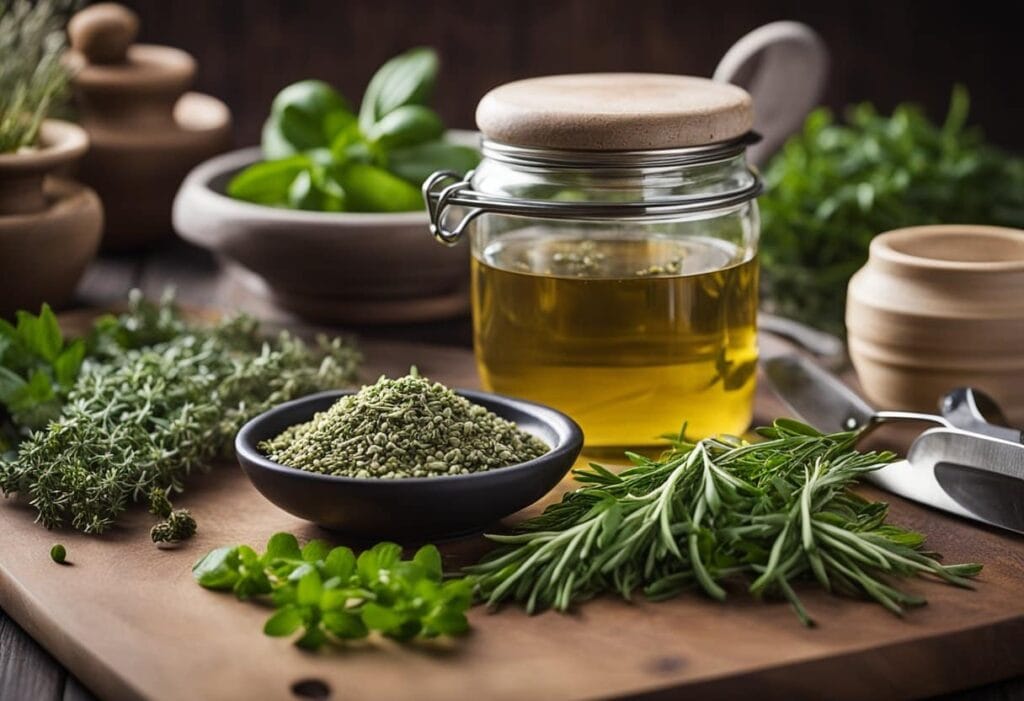
Essential to successful preparation of weed stem tea is the meticulous selection of quality binding agents to ensure proper infusion, as well as sourcing the requisite additional ingredients and kitchenware. Proper execution of these steps lays the groundwork for an effective and enjoyable tea.
Selecting a Binding Agent
Binding agents are crucial for the infusion process to extract THC from the stems, which is not water-soluble on its own. Choices include fats such as butter, oil, and specifically cannabis coconut oil or coconut oil, known for their high saturated fat content which is ideal for THC absorption. Dairy options like milk can also serve as a binding agent, provided it contains enough fat.
Other Required Ingredients
For enhancing the tea, one may incorporate a variety of additional ingredients. Sugar or honey can be added as a sweetener, while a spice such as cinnamon or cardamom may be used for flavor. These should be selected based on personal taste preferences:
- Sweeteners: Sugar, Honey
- Spices: Cinnamon, Cardamom
Required Kitchenware
Proper kitchenware improves the tea-making experience. Gather a pot for boiling water, a tea strainer, and a teapot or cup for serving. Ensure the pot is of ample size to hold enough water for infusing the stems, keeping in mind that some water will evaporate during boiling.
- Boiling: A medium-sized pot
- Straining: Tea strainer
- Serving: Teapot or cup
Step-by-Step Brewing Process
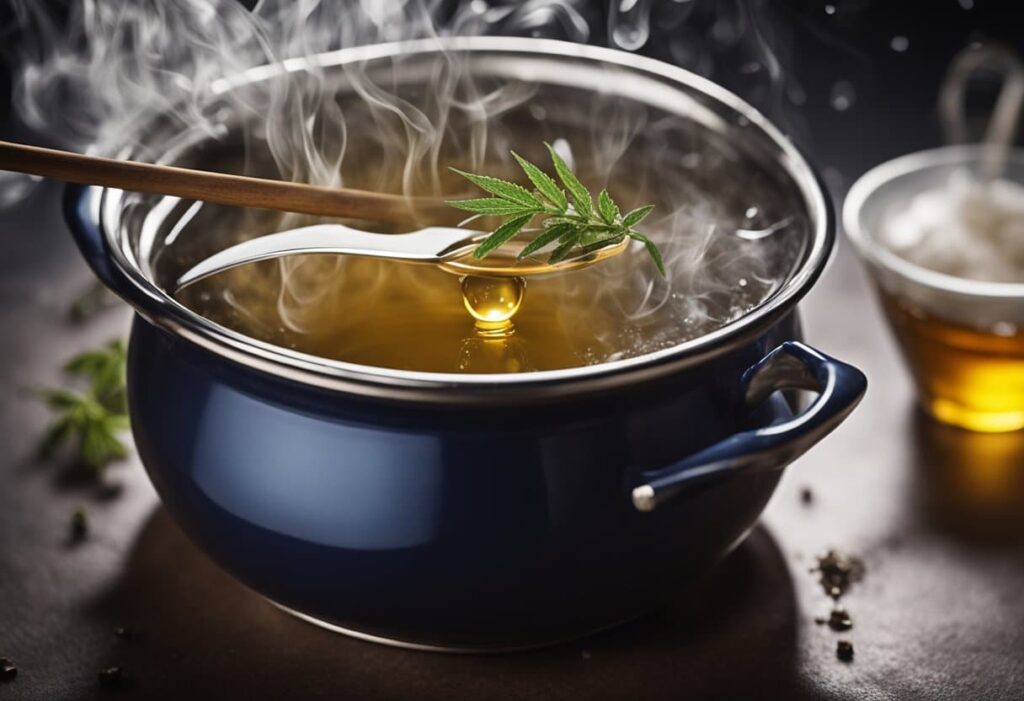
Creating cannabis stem tea involves a series of detailed steps, each crucial for achieving the desired potency and flavor. The process ranges from preparing the stems through grinding and decarboxylation to the final flavoring of the tea.
Grinding and Decarboxylating
Firstly, grind the weed stems coarsely; this increases the surface area, enhancing the extraction of the active compounds. Then, decarboxylate the stems by heating them in an oven. This heat treatment activates THC, turning it from its non-psychoactive form to its active state.
Mixing with a Binding Agent
Cannabinoids are fat-soluble, so mixing with a binding agent such as butter or coconut oil is essential for efficient extraction. The mixture allows THC to be released into the tea, which can then be efficiently absorbed by the body.
Boiling the Mixture
Place the activated stems into a pot and add water with a spoonful of the chosen oil or butter. Boil the mixture for about 10 to 15 minutes to allow the compounds to infuse into the liquid. Ensure to simmer at a controlled temperature to prevent the active ingredients from degrading.
Straining the Tea
After boiling the tea, it’s time to strain out the plant matter to make the tea smooth. A cheesecloth, coffee filter, or a reusable tea bag works well to separate solids from the liquid, resulting in a clearer tea.
Flavoring and Sweetening
Finally, enhance the tea to your taste preference. Additives like honey or sugar can be introduced to add sweetness. Additional flavors such as lemon, mint, or cinnamon can be added to personalize the taste of your cannabis stem tea.
You can learn more about crafting a delicious batch by checking out an amazing weed stem tea recipe.
Customizing Your Tea
Crafting the perfect cup of weed stem tea involves adjusting the potency and experimenting with various milks, flavors, and herbs. Specific preferences for strength and taste can transform the tea from a simple beverage to a customized treat.
Adjusting Potency
The potency of cannabis-infused tea can be regulated by the amount of weed stems used. If the goal is a milder brew, one might use less material, while a stronger infusion could require more. To enrich the tea’s potency, incorporate a fat source like oils or dairy, as cannabinoids bind well to fats, increasing the overall effect.
Variations with Dairy and Non-Dairy Milks
Incorporating milk into weed stem tea can not only affect the flavor but also the uptake of cannabinoids. Options range from traditional dairy milk to non-dairy alternatives like coconut milk or half-and-half. For instance, using coconut milk, which contains natural fats, can enhance the absorption of cannabinoids and offer a tropical note to the tea.
Adding Flavors
To elevate the sensory experience, infuse the brew with a variety of spices such as cinnamon or vanilla. Citrus peels or sweeteners could also be added for their bold accents. The interplay of these flavors with the natural essence of the weed stems creates a more enjoyable tea.
Herbal Mix-Ins
Beyond conventional additives, incorporating other herbs into your weed stem tea can not only provide additional flavor but synergistic effects as well. Common herbal selections include chamomile to soothe or peppermint to invigorate. Each herb can contribute to the desired outcome of the tea, whether it’s relaxation or a burst of freshness.
Remember, the key to a satisfying cup of cannabis-infused tea lies in finding the right balance to suit your personal taste and desired effect.
Serving and Enjoying

When preparing weed stem tea, it is crucial to serve the beverage at the right temperature to ensure maximum enjoyment and preservation of its distinct qualities. Time of consumption also plays an integral role in the tea’s effects and the user’s overall experience.
Optimal Serving Temperature
Weed stem tea, similar to other cannabis tea varieties, is best served hot but not scalding, typically between 160°F to 185°F. This temperature range helps in extracting the cannabinoids without diminishing their potency. Serving the tea too hot can cause discomfort and overshadow the intrinsic flavors of the infused tea.
Best Times to Consume
The appropriate times to consume stem tea largely depend on the intended effects. For individuals looking to harness the calming effects for relaxation or aid with sleep, evenings might be best. However, tea infused with strains known for their energizing properties could be more suitable for morning or early afternoon consumption, providing a more subtle and controlled experience than other methods of cannabis intake. Beverages like stem tea can be incorporated into a routine as one desires, always considering their own body’s reaction and tolerance.
Safety and Legal Considerations
When crafting weed tea, it is crucial to understand the cannabinoid concentrations and acknowledge the varying legal landscapes surrounding cannabis use.
Understanding THC and CBD Levels
The potency of weed tea rests on the THC and CBD levels within the plant material used. THC, the psychoactive compound in cannabis, is responsible for the ‘high’ effect, while CBD is non-psychoactive and often associated with medicinal benefits. Dosage is important; a high THC content can lead to stronger effects, so one should measure carefully to maintain a safe and enjoyable experience.
Legalities of Consuming Cannabis Tea
The legal status of consuming cannabis tea varies by location. In areas where marijuana is legal, there may still be restrictions on how it is consumed and possessed. For instance, in some states, Delta 8 is a permissible cannabinoid, while others may have different regulations. It’s important to stay informed about the local laws, including whether Delta 9 is legal, to ensure compliance and avoid legal issues. Additionally, for those traveling, it’s important to know if places like Colorado accept out-of-state medical cards, as reciprocity can greatly vary.
Frequently Asked Questions
When crafting weed stem tea, enthusiasts often have a series of critical questions concerning preparation and consumption. Addressing these common inquiries helps ensure an optimal experience.
What is the typical duration before feeling the effects of cannabis-infused tea?
Individuals typically begin to feel the effects of cannabis-infused tea approximately 30 to 90 minutes after consumption. This can vary based on metabolism and the concentration of active ingredients.
Can you use any type of cannabis stems for making tea, and are there different effects?
One may use various types of cannabis stems to make tea; however, the effects can differ depending on the THC and CBD content of the stems used. Stems from more potent strains could result in stronger effects.
What is the correct water to stem ratio for making potent marijuana stem tea?
A common ratio is one gram of stems to one cup of water, but this can be adjusted for personal potency preferences. The strength of tea is also dependent on how long the tea is simmered.
Which additional herbs or ingredients can enhance the flavor and potency of cannabis stem tea?
Ingredients like mint, lemon, or chamomile can enhance flavor, while adding fats like coconut oil may increase potency by aiding in the absorption of cannabinoids.
Is it necessary to decarboxylate marijuana stems before brewing tea to feel the effects?
Yes, decarboxylation is necessary to activate the psychoactive compounds within cannabis stems. Heating the stems before brewing can aid in converting non-psychoactive THCa into psychoactive THC.
How do you strain and serve cannabis stem tea properly?
After brewing, the tea should be strained to remove all plant material. Serving the tea can be done in a teacup, and one may consider adding a sweetener or a small amount of milk to enhance taste.






